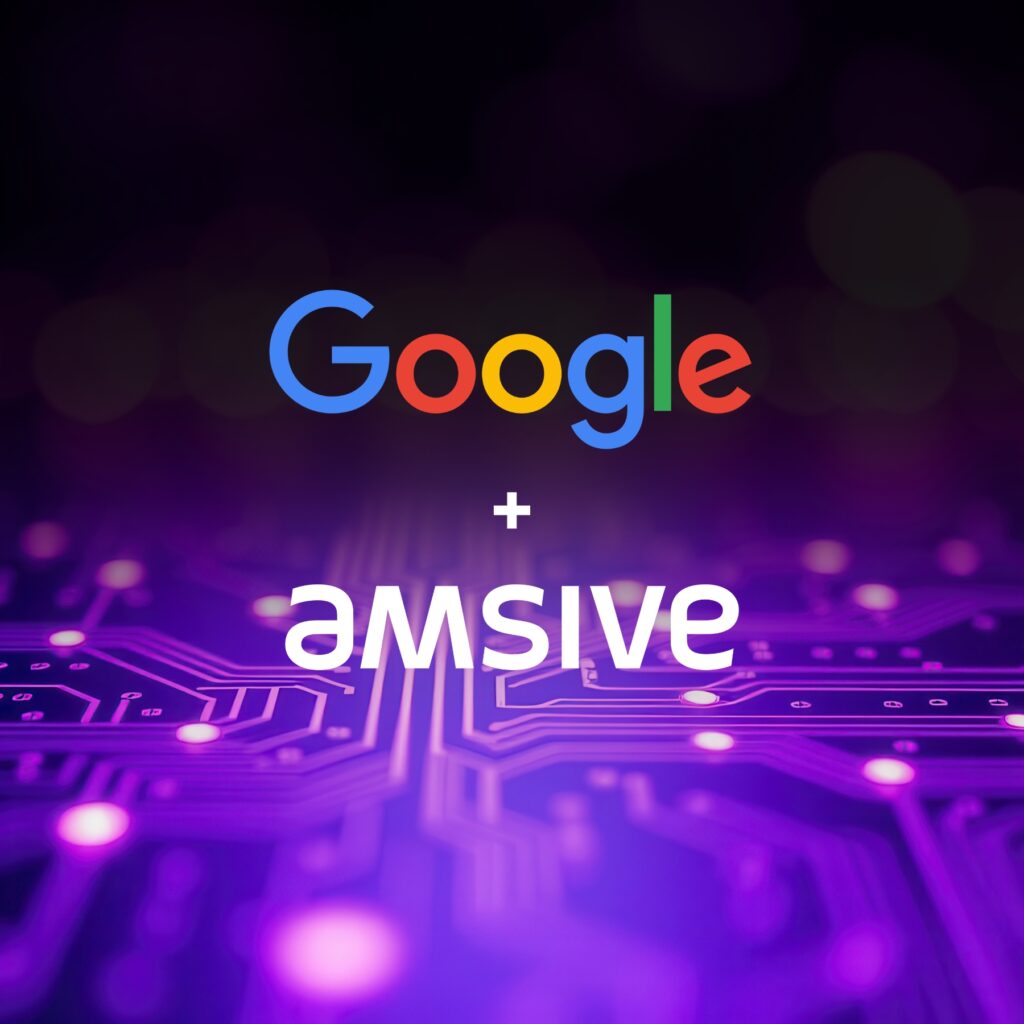With the high turnover of today’s digital marketing landscape, captivating and retaining audience attention is a challenge faced by all marketers. Some tactics, like gamification, encourage customers to engage with an ad or site, and can also increase the likelihood that they’ll recall a particular product or service when they need it next. By leveraging gamification, businesses can turn potentially passive consumers into participants, amplifying their brand impact and driving conversions.
I have a strong memory of an old interactive banner ad from the days of dial-up internet. The ad looked like a carnival game with ducks sliding back and forth across the banner, with little bullseyes sitting on their wings. If you managed to accurately target the bullseye, the banner would open a new page. I think about those ducks more often than I should, but I especially remember them when I run into a new type of gamified ad.
Jump To:
What is gamification?
At its core, gamification incorporates elements commonly found in games into ads, websites, and mobile apps. It leans into our urge to play and compete, driving conversion or participation. Gamification can involve gaining points or badges, completing levels or challenges, earning rewards, or being shown on leaderboards.
Competing in these challenges can foster community and collaboration among a consumer and user base. Leaderboards allow users to compare their performance with others, increasing competition and encouraging them to continue to engage. Social features like sharing achievements or collaborating in challenges can increase engagement and create a competitive and supportive environment.
What are the benefits of incorporating gamification in marketing?
According to Harvard Business Review, you can enhance engagement, drive brand awareness, and achieve marketing objectives by infusing game mechanics and design elements into your strategy. Some of the benefits of incorporating gamification into your marketing strategy can include:
Zero- and first-party data
With the incoming deprecation of third-party cookies, businesses and marketers need to consider and restrategize their data collection methods. Running gamified marketing campaigns can help businesses gather real-time data on user interactions, preferences, and performance. This can help refine further gamification, marketing strategies, audience segmentation, and personalization.
Increased interaction
One aspect of incorporating gamification in marketing is making your site and mobile app more interactive (perhaps by incorporating a bullseye duck or two). Instead of passively scanning or swiping past an ad, a gamified campaign encourages consumers to spend time with your content, making it more likely that they’ll remember your message and recall your brand.
Positive association
Gamification can offer a sense of achievement and progress to consumers. By incorporating aspects like levels, badges, and leaderboards, marketers can reward consumers for participating and encourage them to progress further along the marketing journey.
Consumer action and behavior
Gamified marketing initiatives motivate consumers to take specific actions that align with business objectives, whether it’s encouraging customers to make a purchase, participate in a contest, or share content on social media. By offering benefits, discounts, recognition, or rewards, businesses can incentivize consumers to engage with their brand and drive desired outcomes, such as increased sales, website traffic, or user-generated content.
The data you can gather will vary depending on the type of gamification that you choose to use when engaging your audience.
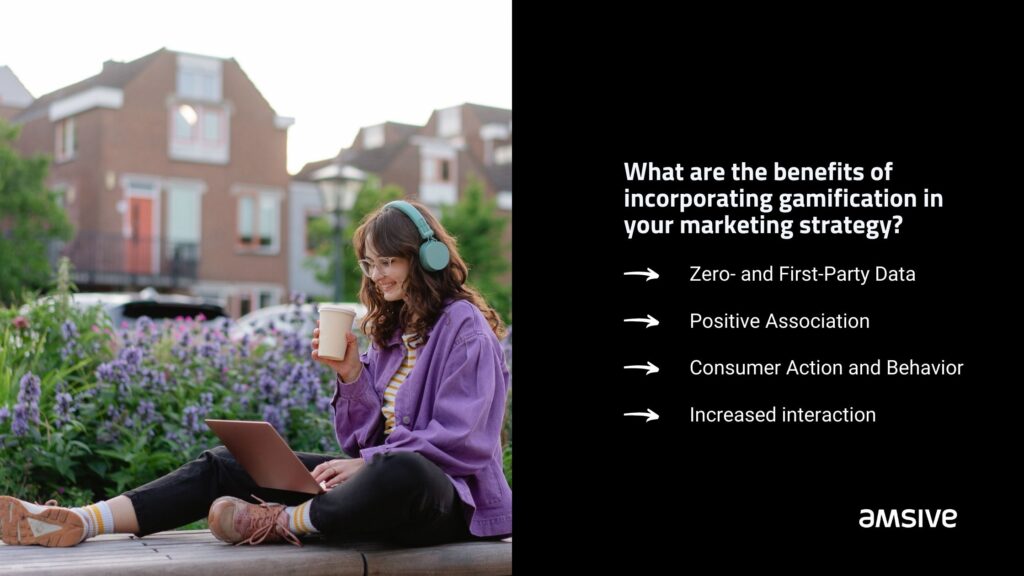
Why knowing your audience improves gamification efforts
Think of your target audience. Which types of gamifications are they likely to engage with and enjoy? Do they prefer website-based or mobile games? Do they value the ability to see their progress for themselves, or is it important for them to share their news on their social platforms? Do they like little freebees (well, who doesn’t?), or would they prefer to spend any accumulated points on one big reward?
Understanding what your audience values in their social spheres and how that fits in with your business and product roadmap will help you choose the type of gamification they’re the most likely to engage with. If your target audience is Gen-Xers, they may prefer a different type of gamification to Gen Zers.
Amsive’s consumer insights make all of these invaluable insights accessible. Our unique Audience Science™ approach harnesses these insights for optimized marketing decisions, guiding businesses in identifying and engaging their highest-value customers. Backed by data and advanced analytics, Audience Science enables precise targeting and effective gamification strategies tailored to audience preferences.
Different types of gamification
You’ve probably engaged with at least one type of gamification. From badges to challenges, let’s look at a few different types of gamification, and some brands that have employed them.
Quizzes
Brands can craft quizzes to educate and entertain consumers, aligning content with their products or services. Quizzes can drive consumer engagement and awareness and gather insights into user behavior and preferences.
Awe Inspired has multiple quizzes that align customer personalities and product types. These quizzes can include questions about personal style, dream home, and what superpower you’d like most. To receive the results of the quizzes, you have to input your email address, allowing marketers to gather data and remarket or promote products to complement a purchase.

Roscato also has a Choose-Your-Own-Adventure-esque cocktail maker that invites users to select their mood, plans, and location’s vibe. The moods vary from bubbly to fierce. The assorted locations include ‘at home,’ ‘on the beach,’ and ‘under the stars,’ to name a few. By selecting different choices, Roscato recommends a custom cocktail for you to enjoy.
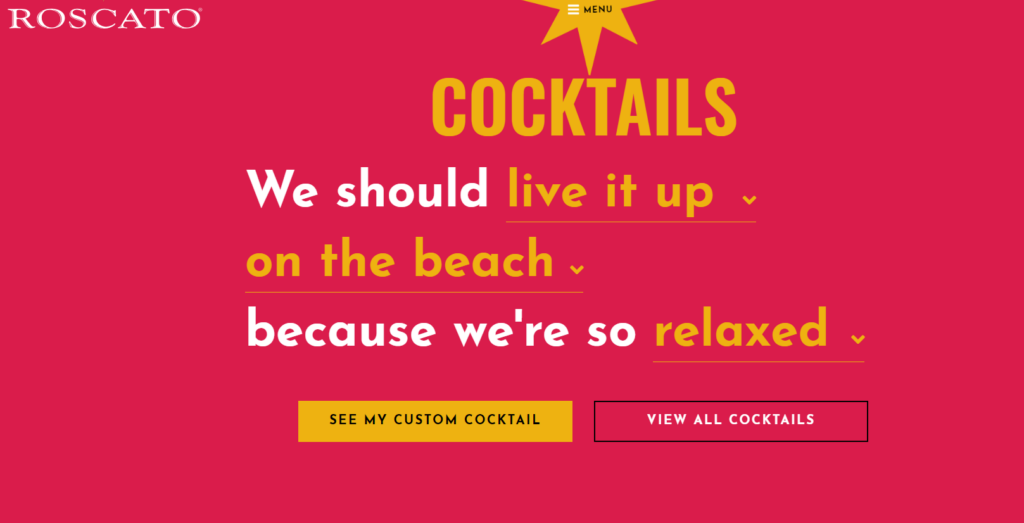
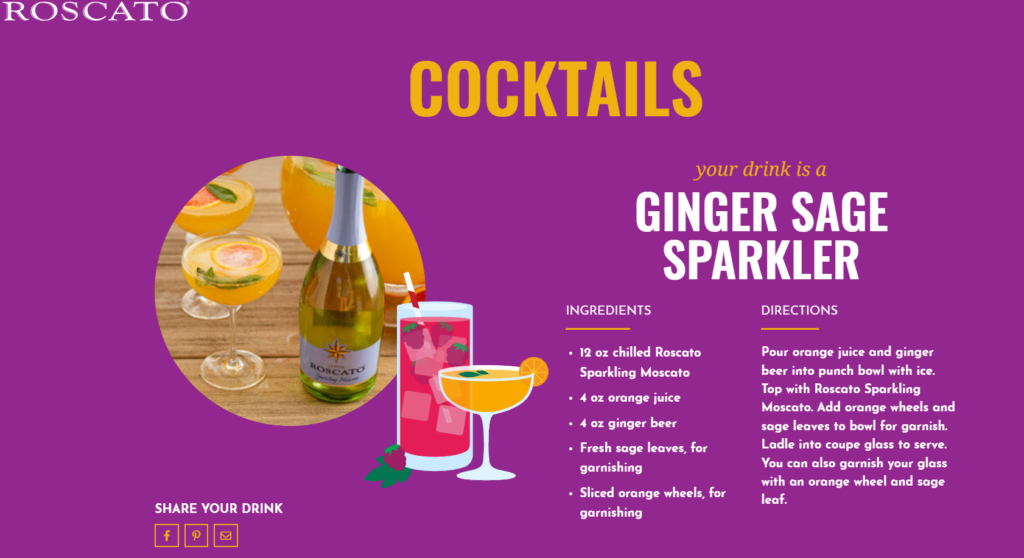
Website game
Website games can immerse consumers in interactive experiences. Brands can create games that are aligned with products and services, integrating promotional content into gameplay. By offering rewards, discounts, or exclusive access once completed, they can incentivize and drive engagement. They can also gather data on consumer preferences.
While it’s less of a game and more of a planning tool, the IKEA Design and Planning Tools allow users to utilize AR to plan and design different rooms throughout their household. You can either use interactive show rooms or scan your room with the IKEA app and use features to erase clutter and visualize rooms. IKEA’s AR experience helps drive engagement, ensuring that their customers engage with relevant products.
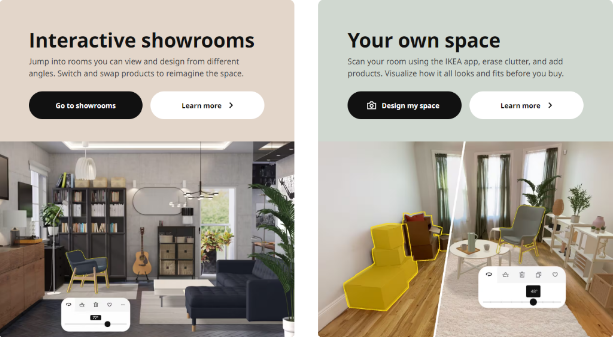
Puzzle
Puzzles offer consumers the chance to engage repeatedly with the goal of completing challenges. Offering incentives like discounts or exclusive rewards increases engagement and encourages consumers to visit or complete conversions repeatedly.
One of the most well-known types of puzzle gamification is the McDonald’s Monopoly Game. Consumers receive a game piece when making a purchase and gain the chance to instantly win rewards, or collect properties around the board to win larger prizes. Players can collect or trade pieces with one another, trying to complete property sets to win cash, cars, or vacations. This boosts McDonald’s sales, can increase brand loyalty, and generate buzz as consumers compete to win prizes.

Countdowns
While countdowns may involve less data collection than some other gamification methods, they effectively build buzz and urgency around an event, product, or promotion. Businesses can incorporate early bird deals or exclusive content or access, motivating users to share socially and keep an eye out as the clock ticks down.
While the holiday season comes but once a year, Amazon’s Prime Day comes twice—or at least, it did in 2023. First introduced in 2015, Amazon Prime Day was created as a celebration of Amazon’s birthday. The hallmarks of Prime Day include deals on big-ticket items and two days of rolling discounts. As of March 28, 2024, no Prime Day has officially been announced, but some news outlets are already speculating about the date and the potential deals. Countdowns can generate anticipation and urgency, and events like Amazon Prime Day offer exclusive deals, driving consumer engagement and excitement.

Virtual badges
Virtual badges can be used in gamification to encourage and reward customer engagement. Businesses can award badges when consumers take a desired action, like marking a purchase, completing a challenge, or participating in an activity. Badges can act as social currency, letting customers show off their accomplishments and giving consumers a deeper sense of community.
Tumblr introduced badges in May of 2023. The badges incorporate different platform-based memes and can also communicate a particular user’s interests or identities. Depending on the badge, it may automatically change depending on longevity, such as the lunar badge, which changes shape over the lunar cycle. They also included an April Fool’s badge that people can earn by sending a ‘boop’ to fellow users, which appears as a cat paw booping your screen. Once you’ve ‘booped’ people a certain amount, a cat paw badge can be added to your profile. Tumblr’s badges enhance user engagement and foster a sense of community through dynamic expression and recognition.

Points
Points can be a virtual currency or scoring system to encourage consumer engagement. They can be earned or rewarded for specific tasks, including purchases, content and social sharing, and completing challenges. How consumers score points should be closely aligned to the desired consumer behaviors. Consumers can cash in for discounts, benefits, or other exclusive rewards as they receive more points. Marketers can also use point scoring to collect data, offering valuable insights into consumer behaviors and preferences.
Delta’s SkyMiles program is a popular example of points-based gamification. The program encourages travelers to consider Delta first when making their travel plans. Miles can be earned from booking flights and participating in specific promotions. SkyMiles can be redeemed for free flights, lounge access, priority boarding, and seat upgrades. They can also be used for partner programs associated with Delta, including hotel stays and dining and shopping rewards.
Like Delta’s SkyMiles program, points-based gamification systems incentivize consumer engagement and reward loyalty. They offer tangible benefits while also providing valuable data insights for marketers.
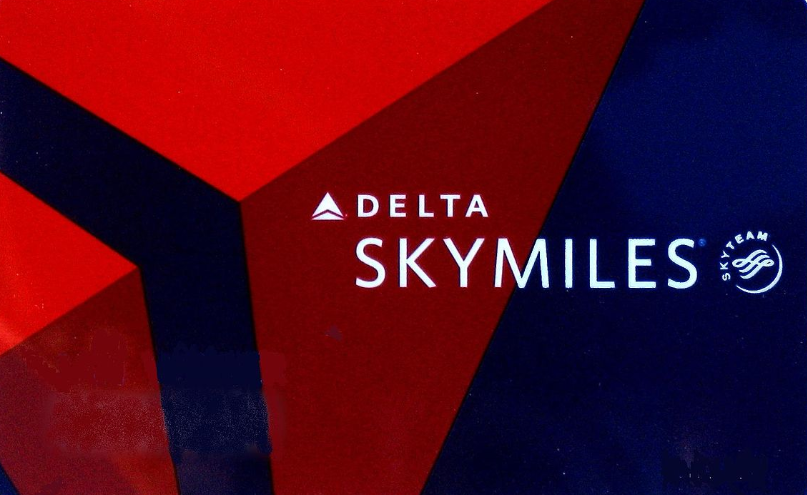
Leaderboards
Leaderboards are a great visual representation of user engagement. They showcase top performers based on specific criteria, like earning points, beating levels, or completing activities. Leaderboards can encourage collaboration and competition between users, driving engagement by providing recognition and status based on ranking. They can also incentivize users to complete a specific action or behavior. You can offer rewards or exclusive benefits, encouraging repeat actions like visits or conversions.
If you’ve ever used Duolingo, you’ve probably gotten at least one push notification from Duo the Owl. You’ve also probably seen your username on a leaderboard as you’ve completed lessons, as Duolingo has different leagues for its users. Users can gain XP by completing lessons, inching them higher up on leaderboards in their league. Once a user has made it into the top 3 of a given league, they get promoted to the next league. Duolingo will also send push notifications to warn users if they’re on the verge of falling out of a certain standing within the league when another user gains more XP than them.
Leaderboards effectively drive engagement by recognizing top performers and fostering competition among a user base.
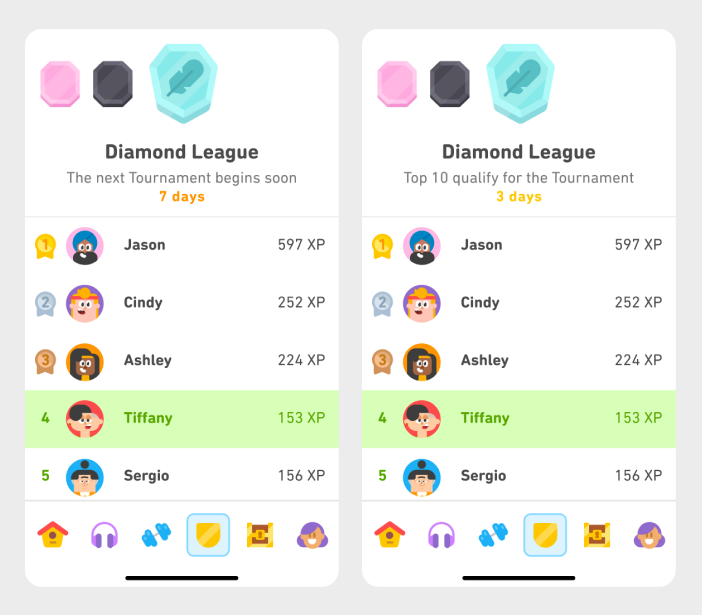
Levels
Like points and leaderboards, leveled gamification systems engage consumers and encourage repeat participation. Each level offers new challenges, rewards, or benefits to give the user a feeling of achievement, motivating users to keep interacting with a brand or product. Offering levels can give a user a solid sense of advancement and progress.
Nike’s Run Club App has levels to help motivate its users and stoke their “competitive spirit.” The app tracks your progress and automatically upgrades your level when you’ve run certain distances.
Leveled gamification systems drive user motivation and satisfaction by offering progressive challenges and rewards based on achievement.
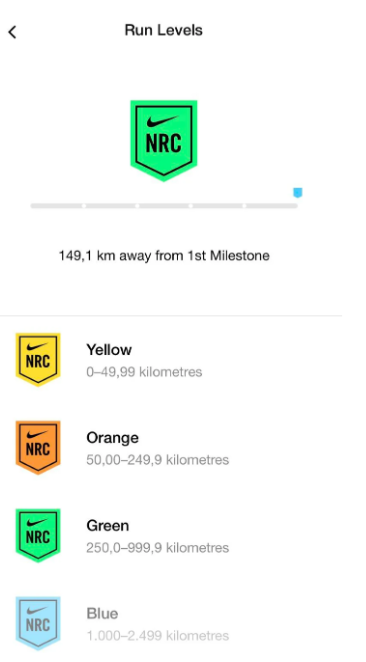
Loyalty programs
Loyalty programs can combine multiple types of gamification, encouraging users to engage with a brand. These programs are gamified by incorporating badges, points, levels, and rewards to encourage customers to repeatedly engage with a product, service, or business. Loyalty programs can collect valuable data and insights into consumer preferences and behavior, helping to personalize and tailor a brand’s marketing efforts.
Starbucks Rewards allows consumers to gain stars for multiple actions and cash the stars in for rewards. The program offers in-app games and purchases, allowing consumers to earn points when they order ahead and pay with the app.
Loyalty programs integrate gamification elements to incentivize customer engagement, foster brand loyalty, and gather valuable consumer data for personalized marketing strategies.
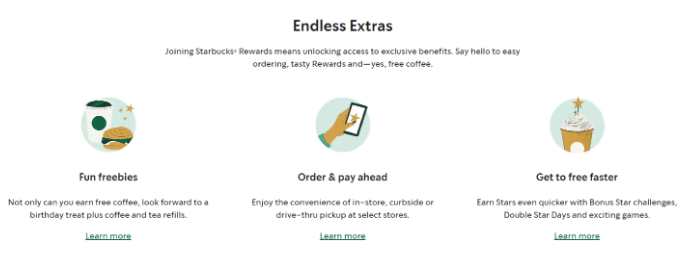
Completion/progress meters
Completion and progress visually represent a consumer’s progress toward a goal. They can encourage consumer action and help give users a feeling of accomplishment as they complete a task or challenge. Users may be more likely to stay engaged and push for completion when they have a stronger visual representation of their goals and progress.
Goodreads has an annual reading challenge goal that allows users to read more and track their progress throughout the year. Users can set a goal for how many books they want to read that year, and as they complete each one, the progress bar inches forward, showing the percentage of their goal that they’ve achieved.
Completion and progress tracking can motivate users by visually displaying their achievements and encouraging continued engagement toward their goals.
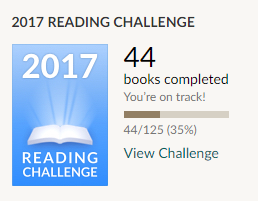
Level up your engagement with gamification
From interactive web and mobile games to loyalty programs that offer points and rewards, gamification can help tap into your consumers’ enjoyment of play and competition. By incorporating game mechanics and design elements into marketing strategies, brands can create immersive experiences that resonate with users on a deeper level, building connections and loyalty.
Whether through quizzes, website games, puzzles, countdowns, virtual badges, or adding achievement levels, marketers can craft tailored experiences that cater to their audience’s unique preferences and motivations.
Learn how to source data once third-party cookies are deprecated, or let’s talk about how we can help you adopt an audience-led strategy for your marketing – and your business.
